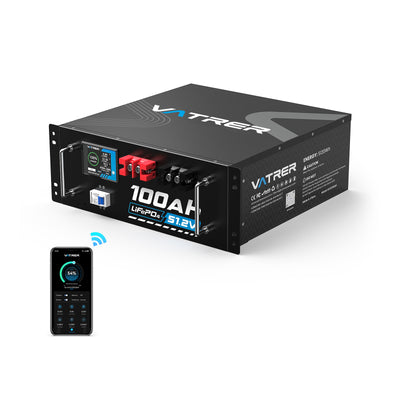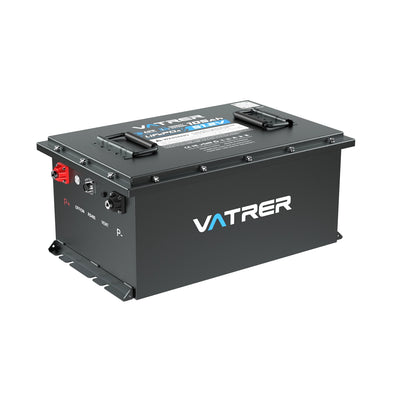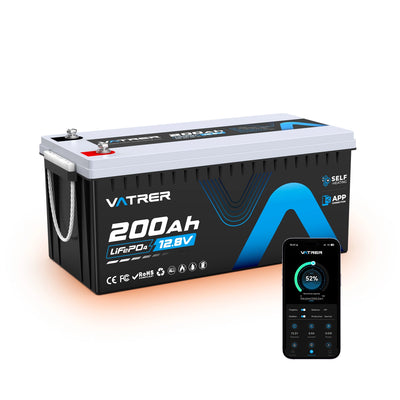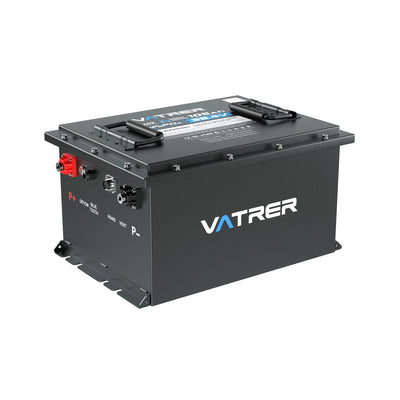
What's The Difference Between 48V And 51.2V Golf Cart Batteries
Picture driving your golf cart for longer distances, with brisker take-off and fewer interruptions. Deciding between a 48V battery system and 51.2V golf cart batteries is central to achieving that. These two voltage setups supply power in different ways, influencing top speed, driving range and ongoing upkeep costs.
Whether you only play a round at the weekend or depend on your cart for resort shuttles or moving around a residential community, understanding the difference between 48V and 51.2V batteries helps you get better value from your cart. In this guide, we compare their characteristics, outline the cost implications and help you decide which option fits your situation.

Exploring 48V vs 51.2V Golf Cart Batteries: Key Features
To understand 48V vs 51.2V properly, it helps to look at what sets each battery system apart and how they integrate with your golf cart.
48V Golf Cart Batteries
48V golf cart batteries are the more traditional solution and are still fitted to many older or cost-conscious models. They usually rely on lead-acid or Absorbed Glass Mat (AGM) batteries wired together to provide a nominal 48V pack.
- Configuration: Typically six 8V or eight 6V batteries in series, working in a range of roughly 42V to 50V during charging and discharging. Standard packs provide around 100–150Ah of capacity.
- Chemistry: Lead-acid or AGM, generally cheaper to purchase but less efficient at storing and releasing energy.
- Applications: Suited to shorter journeys on relatively level golf courses or estate routes with only mild gradients.
- Availability: Easy to source worldwide, with replacements for most mainstream carts readily on hand.
For everyday use they are dependable, but they demand routine maintenance and their service life is noticeably shorter.
51.2V Golf Cart Batteries
51.2V golf cart batteries use modern lithium iron phosphate (LiFePO4) cells and are becoming increasingly popular thanks to their performance and ease of use.
- Configuration: Commonly sixteen 3.2V LiFePO4 cells or four 12.8V modules in series, operating between about 48V and 54V. A 100Ah pack stores roughly 5,120Wh of energy.
- Chemistry: LiFePO4 delivers high energy density, excellent stability and smart functions such as Bluetooth monitoring for live status information. An integrated Battery Management System (BMS) manages charging and shields the pack from over-discharge.
- Applications: Well suited to resort fleets, routes with steeper gradients, or longer drives where consistent power delivery is important.
- Scalability: Compact modules save space and can be connected in parallel to increase total capacity where required.
Vatrer golf cart batteries can cut long-term servicing costs and noticeably upgrade your cart’s performance. They are an excellent match for leading makes such as Yamaha, Club Car and EZGO.
Comparing 48V vs 51.2V Golf Cart Batteries
Now let’s look at how 48V golf cart batteries and 51.2V golf cart batteries differ in the areas that matter most. The table below gives an overview, followed by more detailed explanations to help you understand both systems more clearly.
| Feature | 48V Batteries (Lead-Acid/AGM) | 51.2V Batteries (LiFePO4) |
|---|---|---|
| Power Output | Sufficient for standard driving | Around 10–15% more torque, stronger acceleration |
| Efficiency | Around 80–85% efficient | Roughly 92–98% efficient |
| Weight | Heavier (~240–280 lbs for 100–150Ah) | Much lighter (~80–100 lbs for 100Ah) |
| Charging Time | Around 8–10 hours | Roughly 2–6 hours |
| Lifespan | 2–5 years (about 500–1,000 cycles) | 8–10+ years (4,000+ cycles) |
| Maintenance | Needs regular attention | Effectively maintenance-free |
| Safety | Prone to corrosion and sulphation | Higher safety margin with BMS protection |
Power Output and Acceleration
48V golf cart batteries deliver adequate power for relaxed driving on level ground, although performance tends to tail off as the charge level drops. 51.2V golf cart batteries provide roughly 10–15% more torque, helping carts reach around 25 mph (compared with roughly 20 mph on 48V systems) and climb inclines more confidently, even with several passengers or equipment on board.
Efficiency and Range
Efficiency has a direct influence on how far you can travel per charge. With 48V golf cart batteries operating at about 80–85% efficiency, you can typically expect 20–25 miles on flat ground or 15–20 miles in hillier areas. In contrast, 51.2V golf cart batteries reach efficiencies of about 92–98%, extending real-world ranges to 30–40 miles on level courses or 25–30 miles over undulating routes, especially with a 51.2V 100Ah battery offering 5,120Wh. This makes lithium particularly attractive for 18–36-hole days or mixed terrain.
Weight and Handling
A 48V lead-acid set in the 100–150Ah range typically weighs between 240–280 lbs, which makes the cart heavier to handle and puts more strain on suspension and brakes. By comparison, 51.2V golf cart batteries such as Vatrer’s 100Ah pack at around 99 lbs are roughly 60–70% lighter, which improves steering response and reduces wear on mechanical parts over time.
Charging Dynamics
Charging 48V golf cart batteries usually takes 8–10 hours, which can be inconvenient if the cart is used several times a day. 51.2V golf cart batteries charge much more rapidly, typically within 2–6 hours when paired with a suitable lithium-specific charger. For example, Vatrer’s 58.4V 20A charger can replenish a 100Ah pack in roughly 2 hours, keeping downtime to a minimum.
Lifespan and Maintenance
48V golf cart batteries generally provide 2–5 years of service (around 500–1,000 cycles) and need periodic topping up with water as well as cleaning of terminals. 51.2V golf cart batteries deliver 8–10 years or more (4,000+ cycles), require no topping up and avoid issues such as corrosion or sulphation, which simplifies ownership considerably.
Safety Features
48V golf cart batteries can suffer from corrosion, acid leaks and sulphation if maintenance is neglected. 51.2V golf cart batteries use LiFePO4 chemistry, which is thermally stable and far less likely to overheat. Vatrer batteries incorporate a BMS that offers overcurrent, short-circuit and low-temperature protection (charging is stopped below 32°F), providing an additional layer of safety.
Environmental Impact
From an environmental perspective, 51.2V golf cart batteries offer advantages because they use recyclable materials and last longer, meaning fewer units are discarded over a decade (potentially reducing waste volumes by up to 50%). Traditional 48V lead-acid packs rely on lead and acid, which require careful handling and disposal to minimise environmental harm.
Cost Breakdown: 48V vs 51.2V Golf Cart Batteries
Price is an important consideration when deciding between 48V golf cart batteries and 51.2V golf cart batteries. Here is how the costs typically compare.
Upfront Cost
A 48V lead-acid battery set in the 100–150Ah range generally costs around $800–$1,200, making it appealing for tighter budgets. A 100Ah 51.2V golf cart battery will usually sit between $1,200–$2,500, depending on brand and features.
Long-Term Value
48V golf cart batteries involve regular maintenance and usually need replacing every 2–5 years, which increases total cost of ownership. 51.2V golf cart batteries are maintenance-free and, thanks to their 8–10+ year lifespan, can save roughly $500–$1,000 over a ten-year period. Manufacturers such as Vatrer Battery combine competitive pricing with an intelligent BMS, including Bluetooth connectivity and advanced low-temperature protection, to maintain reliable operation over the long term.
Warranty and Support
Many 48V golf cart batteries are supplied with a 1–2 year warranty. 51.2V golf cart batteries frequently come with 5–10 year coverage, reflecting their extended life. Selecting a reputable supplier such as Vatrer Battery ensures dependable after-sales support and convenient features like Bluetooth monitoring for straightforward maintenance.
Can You Convert from 48V to 51.2V Lithium Batteries?
Moving from 48V golf cart batteries to 51.2V golf cart batteries can significantly upgrade how your cart performs. The key points are:
- Feasibility: Many newer carts from well-known brands such as Club Car and EZ-GO can operate safely within the 48V–54V voltage window associated with 51.2V packs, gaining efficiency and range in the process.
- Compatibility: You should check that your controller is rated for 48V–54V and use a lithium-appropriate 58.4V charger (budget around $100–$300). Some older vehicles may also require modest wiring improvements ($50–$200). Opting for a Vatrer golf cart battery kit simplifies this, as it includes a matched charger and is designed to be fully compatible with the battery.
- Battery Management System (BMS): A robust BMS, standard in Vatrer batteries, safeguards the pack during charging and discharging and helps maintain performance over its lifetime.
- Installation Tips
- Use components recommended by the manufacturer, such as chargers supplied by Vatrer, to avoid compatibility issues.
- Ensure the battery is firmly secured and that there is adequate airflow around it to prevent heat build-up.
- Consult your cart’s handbook or speak to Vatrer for guidance tailored to your specific model. For more complex conversions, professional installation is advisable.
Which Is Right for You: 48V or 51.2V Golf Cart Batteries?
The decision between 48V golf cart batteries and 51.2V golf cart batteries largely depends on how you use your cart and how much you wish to invest.
Choose 48V If
- You are looking for a lower-cost solution (around $800–$1,200) for occasional use, for instance weekend golf with light equipment on relatively flat courses.
- Your cart is an older model originally designed around lead-acid technology.
Choose 51.2V If
- You prioritise stronger performance, extended range and minimal maintenance for regular use, such as resort fleets transporting guests over hilly routes.
- You appreciate benefits like rapid charging and connected monitoring, as provided by Vatrer’s 51.2V golf cart batteries.
The following typical usage scenarios can also help you decide:
- Casual Use: A 48V system comfortably covers short trips on the course with one or two occupants.
- Demanding Use: A 51.2V system is the better option for longer routes, steeper gradients or community transport carrying heavier loads.
- Eco-Conscious Choice: 51.2V golf cart batteries support lower environmental impact through longer life, recyclable components and fewer replacements, reducing waste sent to landfill by as much as 50% over time.
Conclusion: 48V vs 51.2V Golf Cart Batteries Which Is Best?
When weighing up 48V vs 51.2V golf cart batteries, it is important to balance cost, performance and maintenance. 48V golf cart batteries remain a cost-effective and functional option for light, occasional use, but they do require regular care and more frequent replacement. 51.2V golf cart batteries deliver noticeably higher power, up to around 30% more range and over ten years of largely maintenance-free operation, potentially saving $500–$1,000 over the long term. For users seeking the best overall performance, Vatrer Batteries provide 51.2V golf cart batteries with intelligent features and strong technical backing, ideal for modern carts. Always confirm that your cart is compatible and then explore Vatrer’s full range to keep your vehicle running smoothly.
FAQs
How do I know if my golf cart is compatible with a 51.2V lithium battery upgrade?
- Start by checking your golf cart’s handbook or data plate for the controller’s permitted voltage window (modern models from manufacturers such as Club Car or EZ-GO often support 48V–60V).
- Most 48V carts can operate safely within the 48V–54V working range of 51.2V golf cart batteries, although some older vehicles may need a controller upgrade in the region of $200–$500.
- Make sure your existing charger is suitable for lithium batteries (58.4V charge profile for LiFePO4).
- If in doubt, contact the cart manufacturer or a specialist brand like Vatrer for confirmation tailored to your model.
For a straightforward conversion, Vatrer’s 51.2V golf cart battery kits are supplied with compatible chargers, helping to simplify installation.
What are the risks of not maintaining 48V lead-acid batteries properly?
If 48V golf cart batteries based on lead-acid chemistry are not maintained correctly, you may see poorer performance, a shorter life and potential safety concerns.
Failing to keep electrolyte levels topped up can expose the plates, leading to irreversible cell damage and reducing lifespan to as little as 1–2 years.
Corroded terminals increase electrical resistance, which can restrict power delivery and, in some cases, contribute to overheating or electrical faults.
Sulphation (crystalline deposits on the plates) can develop if batteries are left in a discharged state, cutting usable capacity. To prevent this, check water levels roughly once a month using distilled water, clean terminals with a baking soda solution and store batteries fully charged. Moving to 51.2V golf cart batteries, such as Vatrer’s maintenance-free LiFePO4 models, largely avoids these issues.
Can I mix 48V lead-acid and 51.2V lithium batteries in my golf cart?
It is strongly advised not to mix 48V golf cart batteries (lead-acid) with 51.2V golf cart batteries (lithium) in the same system.
The two chemistries have different voltage curves (around 42V–50V for lead-acid vs. approximately 48V–54V for lithium) and require different charging profiles, which leads to unbalanced charging and discharging. This can damage both sets of batteries and potentially stress the controller. Lead-acid units will also discharge more quickly, making the system unstable.
For reliable operation, use a single battery type throughout. If you decide to upgrade, replace the existing 48V pack with a dedicated 51.2V golf cart battery set and pair it with a suitable lithium-specific charger.
How does temperature affect 48V vs 51.2V golf cart batteries?
48V golf cart batteries using lead-acid chemistry are quite sensitive to temperature extremes. At temperatures below 32°F, their effective capacity may fall by 20–30%, shortening your driving range, while high temperatures (above around 90°F) can accelerate electrolyte loss and increase maintenance requirements.
51.2V golf cart batteries (LiFePO4) cope better with temperature variation. They tend to retain over 90% of their capacity in cooler conditions and their stable chemistry slows degradation in warm climates.
Vatrer’s batteries incorporate low-temperature charge cut-offs (stopping charging below 32°F) to maintain long-term health. In colder regions, 48V lead-acid packs should ideally be stored in a sheltered environment, while 51.2V lithium packs should be operated with the BMS active and according to the manufacturer’s guidelines.
Are there specific golf cart models that work better with 51.2V batteries?
Many contemporary golf carts from brands such as Club Car (Precedent, Onward), EZ-GO (RXV, Valor) and Yamaha (Drive2) are designed with controllers capable of handling 48V–60V, which makes them well suited to 51.2V golf cart batteries. Some older vehicles produced before roughly 2000 may have controllers limited to around 50V and can therefore require an upgrade costing in the region of $200–$500.
Always verify the controller’s voltage tolerance and specifications in your cart’s manual. Vatrer’s 51.2V golf cart battery kits are engineered for straightforward integration with these mainstream brands and often include a compatible charger as part of the package.
How can I maximise the lifespan of a 51.2V lithium battery?
To get the full 8–10 years of service from 51.2V golf cart batteries, consider the following practices:
- Always charge with a lithium-specific 58.4V charger to avoid overcharging or incorrect voltage limits.
- Try not to discharge the battery below around 20% on a regular basis, as shallow cycles place less stress on the cells.
- If the cart will be stored for a while, keep the battery at roughly 50–70% state of charge and store it in a cool, dry environment (about 10–25°C / 50–77°F).
- Make periodic checks of the BMS data via Bluetooth, for example with Vatrer’s app, to keep an eye on alerts or fault codes.
Unlike 48V lead-acid packs, lithium batteries do not need water top-ups or frequent cleaning of vent caps, but keeping cable connections tight and free from oxidation will help maintain efficiency.
Can I use 51.2V batteries for non-golf cart applications, like solar storage?
Yes, 51.2V golf cart batteries based on LiFePO4 are versatile and can also be deployed in other systems such as solar energy storage, RV power or marine installations. Their stable voltage, high energy density and integrated BMS make them suitable for these tasks, as long as you use inverters and charge controllers that match their voltage and charging profile.
48V lead-acid golf cart batteries can be used in similar roles but are less efficient and demand more care. Vatrer’s 51.2V golf cart batteries are designed with multi-purpose use in mind and include Bluetooth monitoring, which makes it easier to integrate them into broader power systems.
Share



















































